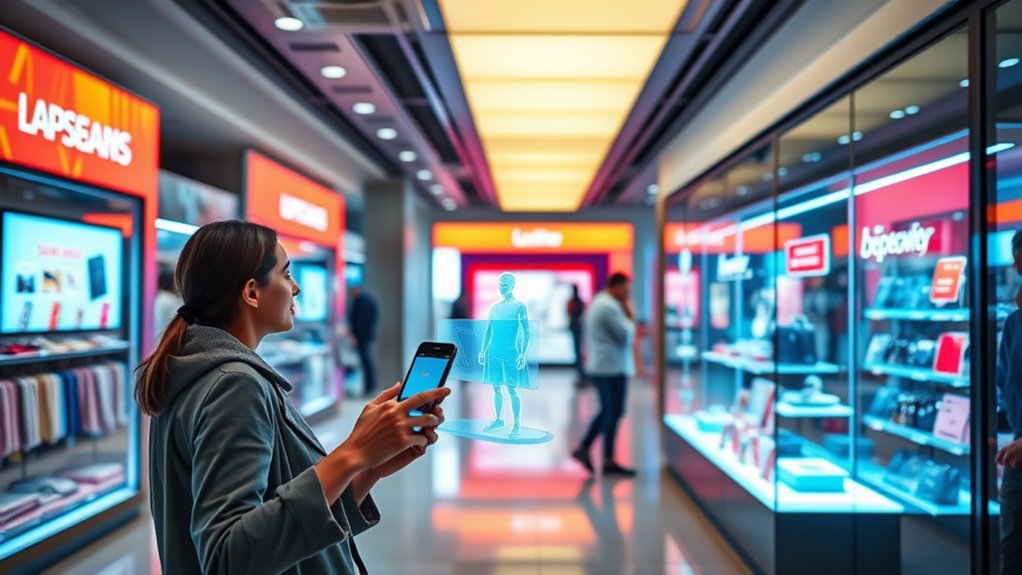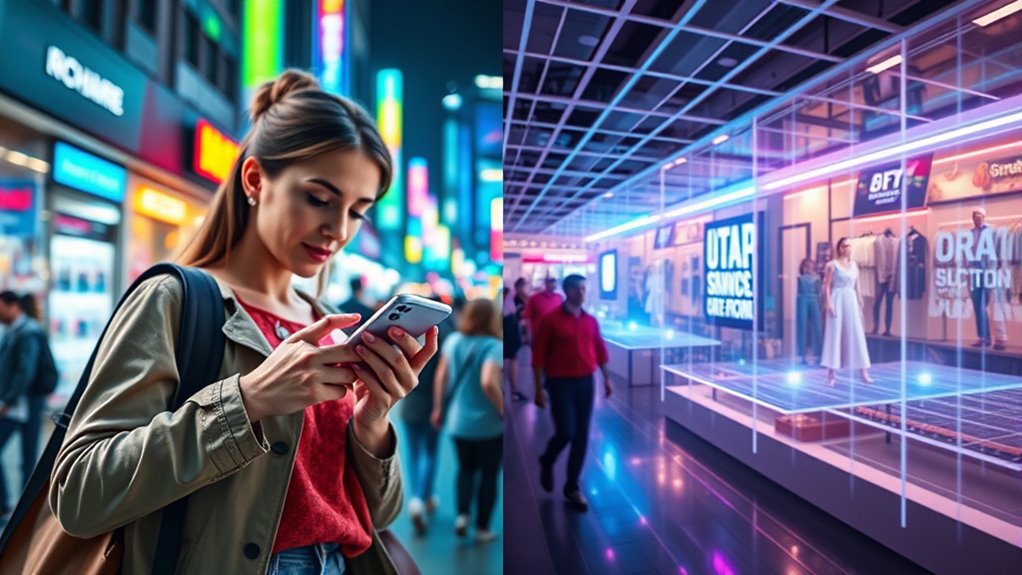To stay competitive, you need to adapt to the shifting landscape of sales channels from mobile commerce to the immersive metaverse. Focus on optimizing your mobile strategies with features like one-click checkout and AR, and embrace social commerce to reach audiences on platforms they frequent. Prepare for the metaverse by exploring virtual stores and immersive shopping experiences, as consumers increasingly seek interactive and personalized digital environments. Keep exploring further to discover how these emerging channels can transform your business.
Key Takeaways
- Embrace mobile commerce features like one-click checkout, QR codes, and AR to meet consumers’ digital and on-the-go shopping habits.
- Leverage social commerce platforms with shopping features, influencer marketing, and live events to reach digital-savvy audiences.
- Incorporate omnichannel strategies combining online, mobile, and physical stores for seamless, personalized customer experiences.
- Invest in AI-driven tools for personalization, predictive analytics, and immersive experiences to stay competitive and efficient.
- Prepare for immersive, metaverse shopping environments offering interactive, 3D virtual storefronts and augmented reality experiences.

Are you ready to explore the future of retail? The landscape is evolving rapidly, and staying ahead means understanding the emerging sales channels shaping consumer behavior. Mobile commerce already dominates, with projections indicating it will account for 62% of all eCommerce sales by 2027. In 2023, the global mobile commerce market was valued at $2.2 trillion, representing 60% of total online sales. This trend is only accelerating, as mobile sales in 2024 are forecasted to reach $558 billion, making up 7.6% of total retail sales. You can’t ignore how consumers increasingly use their smartphones not just for research but for seamless purchasing experiences. In 2023, 80% of shoppers worldwide used their phones to access retailer websites while in physical stores, blending the physical and digital worlds effortlessly. Retailers are responding by implementing features like one-click checkout, faster load times, QR codes, augmented reality (AR), and app-based loyalty programs, all designed to bridge the gap between online convenience and offline engagement. Global eCommerce growth is projected to reach $7.5 trillion in 2025, emphasizing the importance of adapting to these evolving channels. Social commerce is also rising fast, with sales expected to hit $1.2 trillion by 2025. Younger consumers are leading this charge, with 68% of Gen Z searching for products via social media, and 22% completing purchases directly on these platforms. Millennials follow closely, with 42% searching and 21% buying through social channels. The ubiquity of mobile devices, combined with social media shopping features, influencer marketing, and live shopping events, fuels this growth. Platforms are continuously innovating, making it easier than ever for consumers to discover and buy products without leaving their favorite apps. Meanwhile, omnichannel strategies are becoming essential. About 75% of shoppers now use a mix of digital and physical channels throughout their buying journey, from initial research to delivery. You need to leverage data and technology to personalize each interaction, whether through location-based marketing or push notifications that deliver relevant offers at just the right moment. Seamless experiences across online, mobile, and in-store channels help build loyalty and trust, especially when augmented reality tools enable customers to visualize products in real-world settings before buying. The increasing adoption of mobile devices and artificial intelligence is transforming sales processes as well. By 2026, AI will be integral to personalization, predictive lead scoring, and content generation. AI-driven digital sales rooms facilitate multi-stakeholder engagement, offering tailored content and real-time interactions. This shift allows you to target entire decision-making units rather than individual buyers, making your outreach more efficient and effective. Looking ahead, the expansion of eCommerce into new channels like the metaverse is inevitable. As internet penetration and mobile adoption grow, online sales are projected to reach $7.5 trillion by 2025. Consumers increasingly expect immersive, interactive shopping experiences beyond traditional screens. To succeed, you must adapt to these emerging channels and prepare for a future where retail is more integrated, personalized, and digital than ever before.
Frequently Asked Questions
How Can Small Businesses Effectively Adopt Metaverse Sales Strategies?
To effectively adopt metaverse sales strategies, you should start with low-cost virtual storefronts on platforms like Decentraland or Roblox. Incorporate immersive AR/VR experiences to engage customers, and create digital assets like NFTs to boost loyalty. Focus on cross-platform compatibility, build a strong community through events, and analyze user behavior to refine your approach. Pilot projects, address privacy concerns, and leverage social features to maximize your ROI in the metaverse.
What Are the Security Concerns With Metaverse Transactions?
You should be aware that metaverse transactions come with some delicate security concerns. Identity verification needs to be robust to prevent impersonation and fraud, using biometric methods like iris or voice recognition. Protecting digital wallets and smart contracts from vulnerabilities is essential to avoid financial losses. Additionally, safeguarding user data from cyber threats and ensuring secure, transparent transaction records help maintain trust and prevent potential breaches in this evolving digital landscape.
How Do Mobile Sales Channels Impact Customer Loyalty?
Mobile sales channels directly boost your customer loyalty by offering personalized experiences and convenience. You can use mobile apps to deliver exclusive offers, real-time updates, and easy access to rewards, making customers feel valued and engaged. When you prioritize user-friendly interfaces and secure transactions, you build trust. This consistency and targeted engagement encourage repeat purchases, increase customer lifetime value, and foster long-term loyalty, giving your brand a competitive edge.
What Technologies Are Essential for Integrating Mobile and Metaverse Platforms?
Think of the bridge between mobile and metaverse as a digital highway. You need VR/AR tech to create immersive experiences, AI to personalize interactions, and blockchain for secure ownership. Network infrastructure like 5G guarantees smooth rides, while development tools build your virtual storefronts. Together, these technologies form the road that guides your customers seamlessly from their mobile devices into the metaverse, making shopping engaging and effortless.
How Will Emerging Channels Influence Traditional Brick-And-Mortar Retail?
Emerging channels will reshape your brick-and-mortar retail by transforming stores into experiential hubs that blend physical and digital experiences. You’ll need to incorporate AR, virtual showrooms, and interactive kiosks to stay relevant. As virtual shopping grows, you might reduce store sizes or redesign layouts for immersive tech. Your role shifts toward offering tactile experiences while leveraging digital tools, making your stores more engaging and competitive in an evolving retail landscape.
Conclusion
As you prepare for the future, remember that 73% of consumers now shop across multiple channels, making it essential to embrace emerging sales avenues like mobile and the metaverse. Staying ahead means integrating these channels into your strategy now, so you don’t miss out on potential sales. By doing so, you’ll connect with your customers where they’re already engaging, ensuring your business remains relevant and competitive in this rapidly evolving landscape.









